AMD’s 5 GHz Turbo CPU in Retail: The FX-9590 and ASRock 990FX Extreme9 Review
by Ian Cutress on August 9, 2014 8:00 AM ESTCPU Benchmarks: Comparing Motherboards
Readers of our motherboard review section will have noted the trend in modern motherboards to implement a form of MultiCore Enhancement / Acceleration / Turbo (read our report here) on their motherboards. This does several things – better benchmark results at stock settings (not entirely needed if overclocking is an end-user goal), at the expense of heat and temperature, but also gives in essence an automatic overclock which may be against what the user wants. Our testing methodology is ‘out-of-the-box’, with the latest public BIOS installed and XMP enabled, and thus subject to the whims of this feature. It is ultimately up to the motherboard manufacturer to take this risk – and manufacturers taking risks in the setup is something they do on every product (think C-state settings, USB priority, DPC Latency / monitoring priority, memory subtimings at JEDEC). Processor speed change is part of that risk which is clearly visible, and ultimately if no overclocking is planned, some motherboards will affect how fast that shiny new processor goes and can be an important factor in the purchase.
Point Calculations – 3D Movement Algorithm Test: link
3DPM is a self-penned benchmark, taking basic 3D movement algorithms used in Brownian Motion simulations and testing them for speed. High floating point performance, MHz and IPC wins in the single thread version, whereas the multithread version has to handle the threads and loves more cores.
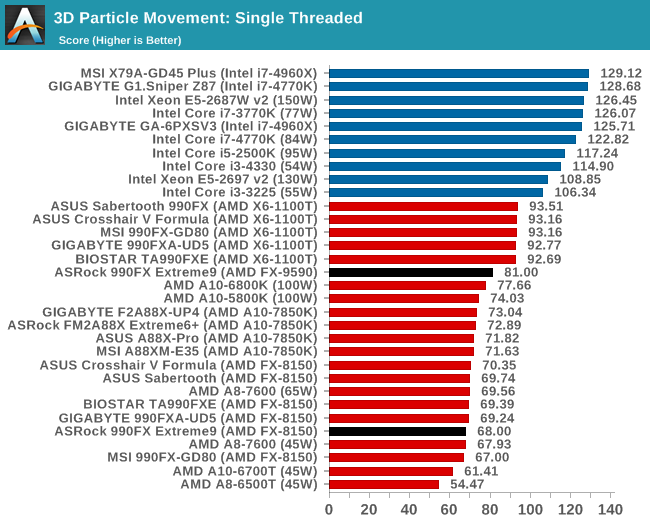

Compression – WinRAR 5.0.1: link
Our WinRAR test from 2013 is updated to the latest version of WinRAR at the start of 2014. We compress a set of 2867 files across 320 folders totaling 1.52 GB in size – 95% of these files are small typical website files, and the rest (90% of the size) are small 30 second 720p videos.
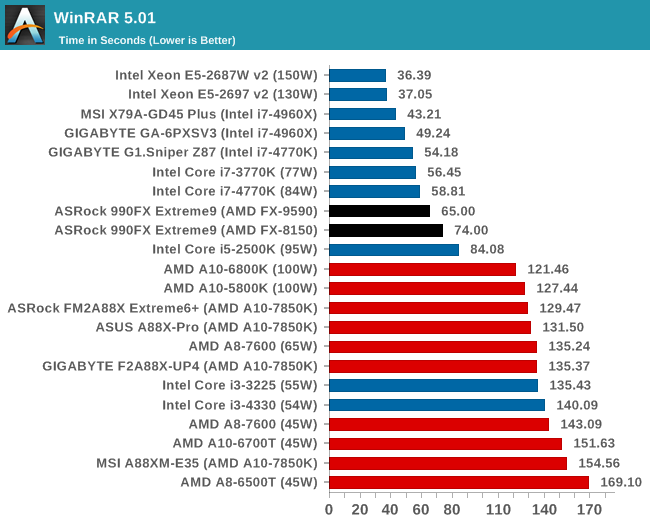
Image Manipulation – FastStone Image Viewer 4.9: link
FastStone is the program I use to perform quick or bulk actions on images, such as resizing, adjusting for color and cropping. In our test we take a series of 170 images in various sizes and formats and convert them all into 640x480 .gif files, maintaining the aspect ratio. FastStone does not use multithreading for this test, and results are given in seconds.
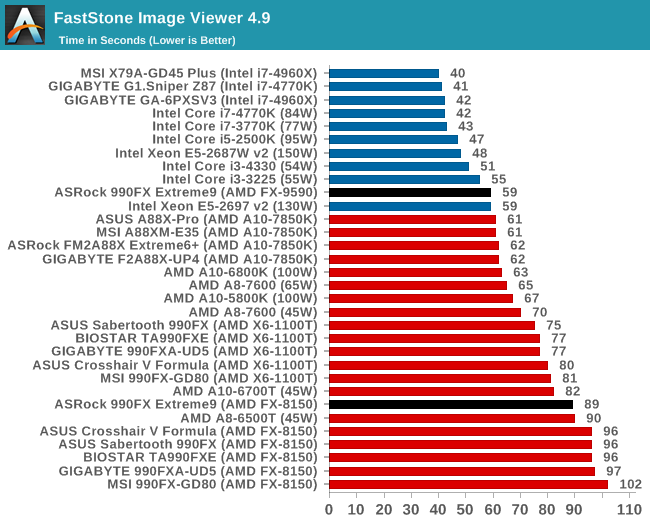
The FX-8150 result for the Extreme9 compared to other motherboards shows one of two things - the latest Windows SP1 with core parking updates has an effect, or the BIOS is more efficient at handling turbo modes than our older reviews.
Video Conversion – Handbrake v0.9.9: link
For HandBrake, we take two videos (a 2h20 640x266 DVD rip and a 10min double UHD 3840x4320 animation short) and convert them to x264 format in an MP4 container. Results are given in terms of the frames per second processed, and HandBrake uses as many threads as possible.
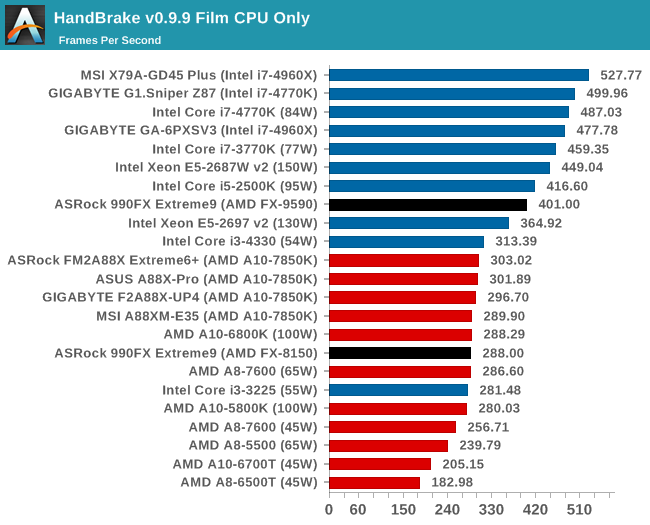

Rendering – PovRay 3.7: link
The Persistence of Vision RayTracer, or PovRay, is a freeware package for as the name suggests, ray tracing. It is a pure renderer, rather than modeling software, but the latest beta version contains a handy benchmark for stressing all processing threads on a platform. We have been using this test in motherboard reviews to test memory stability at various CPU speeds to good effect – if it passes the test, the IMC in the CPU is stable for a given CPU speed. As a CPU test, it runs for approximately 2-3 minutes on high end platforms.
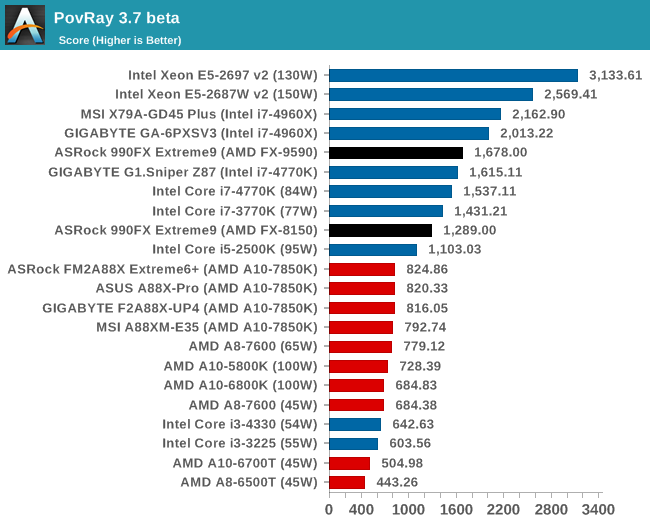
Synthetic – 7-Zip 9.2: link
As an open source compression tool, 7-Zip is a popular tool for making sets of files easier to handle and transfer. The software offers up its own benchmark, to which we report the result.
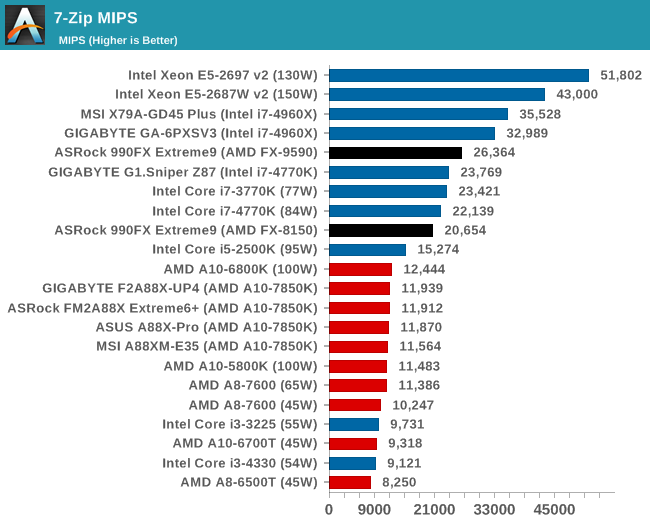










146 Comments
View All Comments
Flunk - Saturday, August 9, 2014 - link
The likelyhood of an existing AM3+ owner having a board that can support a 250watt CPU is pretty low, there really aren't many options. This CPU is a real turkey and people are not buying them.TiGr1982 - Saturday, August 9, 2014 - link
220 W, not 250, but this does not change your statement :)basroil - Sunday, August 10, 2014 - link
220W TDP, the chart above shows it uses 237W without overclocking! AMD needs to get their stuff togethertakeship - Sunday, August 10, 2014 - link
Yeah, AMD's "220" is 220w of heat, not necessary 220w of power. You'll measure more, maybe a lot more, at the wall.Death666Angel - Sunday, August 10, 2014 - link
That is the whole system, the mainboard, the drives, dedicated graphics card, conversion loss by your PSU. Get your facts straight.@takeship: Where would that 220W of heat come from is not from the power? Does the CPU somehow produce more heat from chemical reactions?
anubis44 - Sunday, August 10, 2014 - link
Well, one pro is that you get a processor that is fairly comparable to an Intel i7 in performance, and most importantly, you'll be giving your money to a company that didn't try to screw you by attempting to corner the market through extortionate threats to their own OEM customers if they used AMD CPUs when they were better than Intel's.In other words, there may not be any technical advantages over Intel's competing products, but there are also no significant disadvantages, and at least by buying AMD, you won't feel like you need to take a bath afterwards to wash the filth off. I say to hell with Intel. Stop giving them money as punishment for their gangsterism.
asoltesz - Wednesday, August 13, 2014 - link
Mostly, this is why I bought an AMD desktop last year. It was similar in price than an Intel-one would have been for the same money. It consumes much more energy but that was something I could put up with.FITCamaro - Saturday, August 9, 2014 - link
Man I seriously don't want to live in England if your electricity is that expensive. That's $0.30 cents/kWh. But with our current president and administration who want our electricity prices to rise, we might soon be in that boat. I pay about $0.06/kWh.lkb - Saturday, August 9, 2014 - link
Here in germany we pay 54 Euro Cents/kWh during peak times. While it sucks it has it upsides too - no stupid bitcoin mining crazy to speak of around here!TiGr1982 - Saturday, August 9, 2014 - link
Well, then I doubt you will go with FX - even despite the fact, that FX CPU dies are actually produced in Germany at Drezden GloFo Fab 1 :)